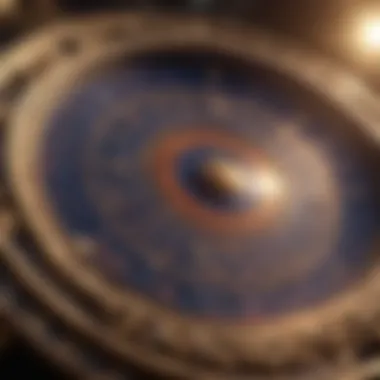Unlocking the Secrets of Your Astrology Natal Chart


Intro
Astrology is an ancient practice that provides insights into our lives and personalities. At its core lies the natal chart, a cosmic map created at the moment of one’s birth. Understanding the natal chart is essential for anyone looking to explore astrology's depths. This section will introduce the key components of the natal chart, its importance, and how it can enhance self-awareness. By examining the stars and planets, we can grasp the unique influences they have on our lives.
Understanding the Zodiac
Overview of Zodiac Signs
The Zodiac consists of twelve signs, each with distinct characteristics and qualities. These signs are based on the position of the sun at the time of birth. They encompass a range of traits that reflect our inherent nature. Each sign holds its unique symbolism and significance, shaping individual personalities and behaviors.
Sign Traits and Characteristics
Every Zodiac sign offers a different perspective. For instance:
- Aries is known for being energetic and pioneering.
- Taurus emphasizes stability and patience.
- Gemini is notable for its adaptability and communication skills.
- Cancer embodies nurturing and emotional depth.
Understanding these traits allows individuals to recognize their strengths and weaknesses, fostering personal growth.
Elemental Qualities
The Zodiac signs can also be categorized by four elemental qualities: fire, earth, air, and water. Each element influences the behavior and characteristics of its corresponding signs.
- Fire Signs (Aries, Leo, Sagittarius): known for their passion and enthusiasm.
- Earth Signs (Taurus, Virgo, Capricorn): characterized by practicality and realism.
- Air Signs (Gemini, Libra, Aquarius): associated with intellect and social connection.
- Water Signs (Cancer, Scorpio, Pisces): often described as intuitive and emotional.
These elemental associations enrich the understanding of how signs interact with one another.
Astrological Insights
Current Astrological Trends
Awareness of current astrological trends can enhance our understanding of influences affecting us today. Planets move through the Zodiac, creating dynamic energies that can be felt universally.
Influence of Celestial Events
Significant celestial events, such as eclipses and retrogrades, also play a role in shaping experiences. For instance, a Mercury retrograde is often associated with communication breakdowns, emphasizing the need for clarity in dialogues.
In addition, new moons and full moons initiate cycles of beginnings and endings, urging reflection and transformation. Understanding these influences helps individuals navigate personal challenges more effectively.
How to Interpret Your Birth Chart
Interpreting a natal chart involves analyzing the placement of celestial bodies at one’s birth. Key factors include:
- Sun Sign: Represents core self and ego.
- Moon Sign: Reflects emotional responses.
- Rising Sign: Indicates outward identity and first impression.
Understanding these elements allows individuals to see the interplay between different aspects of their personalities, leading to greater self-awareness.
Horoscope and Predictions
Monthly or Weekly Forecasts
Many seek guidance through horoscopes, which offer insights based on current planetary positions. Monthly or weekly forecasts can help individuals align their actions with cosmic energies.
Personalized Horoscope Reading
A personalized horoscope reading considers the unique natal chart. This custom analysis can reveal specific trends and opportunities that resonate with one’s birth details.
Compatibility Readings based on Zodiac signs
Compatibility readings between different Zodiac signs provide valuable insights into relationships. While some signs naturally harmonize, others may require more effort to connect. Knowing these dynamics can enhance relationship understanding.
“Astrology is a language. If you understand this language, the sky speaks to you.” – Dane Rudhyar
By diving into these facets of astrological study, one can develop a profound connection with oneself and others, facilitating genuine growth and understanding.
Intro to Astrology Natal Charts


Astrology natal charts serve as a personalized blueprint of an individual's potentialities based on celestial positions at the time of their birth. Understanding these charts is essential for those who want to explore their unique cosmic imprint. The study of natal charts offers numerous benefits, from facilitating self-understanding to enhancing interpersonal relationships. By deciphering the rich data embedded in the charts, individuals can unlock pathways to personal development and self-reflection.
Definition of a Natal Chart
A natal chart, also known as a birth chart, is a map of the sky at the precise moment of one's birth. It outlines the positions of the planets, the sun, and the moon across various astrological signs and houses. Each element in a natal chart contributes to an individual's personality, emotional responses, and life experiences.
Key components include:
- Planets: Represent various aspects of oneself and influences in life.
- Signs: Provide the qualities and traits associated with each planet's energy.
- Houses: Indicate life areas where the energies manifest.
When one analyzes their natal chart, they access a wealth of insight that can guide their personal journeys.
History of Natal Chart Usage
The origins of natal chart usage trace back thousands of years to ancient civilizations. The Babylonians are often credited with the early development of astrology, where they connected planetary movements with human affairs. Over time, this practice was adopted and refined by other cultures, including the Egyptians and Greeks.
By understanding the history, one appreciates how astrology's importance has endured.
- Babylonian Influence: From around 2000 BCE, these early astrologers created star catalogs and recognized celestial patterns.
- Greek Contributions: Figures such as Ptolemy further systematized astrology, giving us some foundational texts used today.
- Modern Adaptation: In recent years, natal charts have gained popularity among the general public, largely due to the growth of new-age practices and digital tools.
In essence, the knowledge surrounding natal charts has evolved, yet its core value persists as a means for individuals to navigate their lives more consciously.
Components of a Natal Chart
Understanding the components of a natal chart is essential for anyone interested in astrology. The natal chart serves as a blueprint of an individual's potential and characteristics based on the positions of celestial bodies at the time of their birth. Each element within the chart contributes unique insights, making the study of these components critical for accurate interpretations.
Zodiac Signs
Overview of the Twelve Signs
The twelve zodiac signs form the foundational framework of astrology. Each sign has distinct qualities and governs specific traits. Knowledge of these signs allows for a richer understanding of personality in the natal chart. For example, Aries is known for its assertiveness, while Pisces embodies sensitivity. This diversity is beneficial as it provides multiple angles for interpretation.
A unique feature of the signs is their progression through the astrological year. Each sign signifies different energies and influences that can change based on the placements in a natal chart. This quality enables the astrologer to craft personalized interpretations based on an individual's traits.
Elemental Associations
In astrology, the twelve zodiac signs are categorized into four elemental groups: Fire, Earth, Air, and Water. This classification is crucial because it provides insights into the nature of each sign. For instance, Fire signs are known for their dynamism, while Earth signs are practical and grounded.
The elemental associations enhance understanding by offering additional layers to chart interpretation. They help highlight compatibility between different signs and underline innate tendencies within a person. Each element's unique advantages lie in providing context for emotional and rational responses in life.
Planets
Significance of Each Planet
The planets in astrology are much more than mere celestial bodies. Each planet symbolizes different aspects of human experience. The Sun represents core identity and ego, while the Moon represents emotions and instincts. This differentiation helps delineate internal and external influences in one's life.
Each planet's unique influence on a person's natal chart is significant. These associations inform astrologers about emotional responses, social interactions, and even career paths. Understanding these significances can reveal deep truths about personal motivations and desires.
Planetary Positions
The locations of planets at the exact moment of birth mark the ongoing influences in a person's life. For example, if Saturn is in the fourth house, this could suggest challenges related to home and family. Planetary positions are crucial since they dictate how each planet's qualities interact with the individual.
A notable aspect of planetary positions is their ability to provide insights into timing and trends in life. Some positions can signify favorable periods for taking risks or indicate caution, thus serving as practical guides for personal development.
Houses
Meaning of Each House
In astrology, houses divide the natal chart into distinct areas of life experiences. Each of the twelve houses represents different themes, from personal identity and finances to relationships and career. This segmentation is essential for comprehensive chart analysis.
The significance of houses lies in their ability to pinpoint where in a person's life specific influences apply. For instance, the 7th house relates to partnerships, while the 10th house focuses on vocation. By examining these areas, astrologers can offer well-rounded interpretations of a person’s life.
Activity in Different Houses
The activity in houses changes depending on the planetary placements and influences at play. For example, if multiple planets reside in one house, it could amplify the topics related to that house, leading to heightened experiences in that area of life.


This dynamic nature of house activity provides the astrologer with invaluable insights. Observing how various planets interact within houses can unveil patterns and themes that may affect a person’s decisions and life trajectory.
Essentials of Chart Interpretation
Understanding how to interpret a natal chart is central to the astrological practice. A natal chart serves as a personalized map that reveals insights into one's character, tendencies, and potential life paths. By evaluating this chart, individuals can gain clarity on their strengths and weaknesses, improve their decisions, and enhance their self-understanding. The essential components for effective chart interpretation include reading planetary positions, understanding aspects, and recognizing the role of angles within the chart.
Reading Planetary Positions
Planetary positions provide the foundation for any natal chart interpretation. Each planet represents a unique facet of personality and experience. The signs that these planets occupy at the time of birth inform us about how these energies manifest in daily life.
For example, the Sun's placement can indicate one's core identity and vitality, while the Moon's position falls in line with emotions and instincts. Understanding the aspects of each planet helps in unravelling the nuances of an individual’s character. Hence, interpreting these positions correctly is critical for providing accurate insights.
Understanding Aspects
Aspects are the angles that planets form with each other within the natal chart. These relationships greatly inform one's personality traits and potential challenges. In this section, we will discuss three particular aspects: conjunctions, squares, and trines.
Conjunctions
Conjunctions occur when two or more planets align closely in the same sign. This aspect is notable for its potential to amplify the energies of the involved planets. When well-placed, conjunctions can create a powerful synergy, fueling creativity or ambition. They are often seen as favorable, fostering strengths that individuals can harness.
However, the intensity of conjunctions can also lead to challenges. When the energies clash or become overwhelming, it may create inner tensions. Recognizing this duality is essential for those interpreting conjunctions in their charts.
Squares
Squares present a different energy; occurring when planets are about 90 degrees apart, they create tension and challenges. This aspect signals internal conflict. Such conflicts can drive growth but require conscious effort to navigate successfully. Squares often manifest as obstacles that prompt individuals to confront their reality.
While squares are generally viewed as more challenging than conjunctions, they are not solely negative. They bring learning opportunities and help to catalyze personal development. Recognizing squares in a natal chart can prepare individuals for inevitable challenges while also guiding their growth journey.
Trines
Trines occur when planets are positioned about 120 degrees apart, indicating a harmonious relationship. Often seen as one of the more favorable aspects, trines facilitate an easy flow of energy. This aspect often denotes talents and gifts that come naturally. Those with trines may find things coming together effortlessly, as this alignment promotes positivity and creativity.
Despite their apparent advantages, it is crucial not to overlook the potential pitfalls of trines. Sometimes, the ease associated with this aspect may lead individuals to become complacent or take their gifts for granted. Understanding trines can indicate where to focus growth and appreciate innate abilities.
Role of Angles
The angles in a natal chart, or the relationship of planets to the horizon and meridian, provide additional layers of interpretation. These angles shed light on situations concerning life’s public and private realms. They define how personal drives and desires interact with societal expectations. Strong angles, especially the Ascendant and Midheaven, define one's outer personality, how they present themselves, and their public aspirations.
Understanding these angles is not only about identifying external appearances but also about recognizing the deeper motivations that drive behaviors. The angles bring clarity about one's purpose and how to align personal goals with life’s broader journey.
Interpretation of natal charts goes beyond surface readings. The interplay of various elements sets the stage for a richer understanding of one’s life.
To summarize, understanding the essentials of chart interpretation holds great significance for any astrologer. The necessary skills to read planetary positions, comprehend aspects, and analyze angles can greatly enhance one's astrological practice and enable deeper insights into human behavior.
Creating Your Own Natal Chart
Creating your own natal chart is an essential step in understanding the astrological influences at play in your life. This process enables individuals to engage directly with their celestial fingerprints, providing insights into their personalities, strengths, and challenges. This personalized approach allows for a deeper connection to astrology as a tool for self-awareness and growth. The simple act of chart creation facilitates a more profound understanding of one's path in life.
Necessary Information
Birth Date
The birth date serves as the foundational element of a natal chart. It pinpoints the position of the sun, moon, and planets at the exact moment of birth. A person's birth date is a key characteristic as it establishes the zodiac sign under which they were born. This characteristic is essential because it guides the interpretation of other astrological elements. The unique feature of the birth date is how it can reflect one's evolving identity over time. However, knowing just the birth date without the time or location can lead to a less accurate chart, which limits the insights that one can obtain from it.
Birth Time
Birth time is equally crucial. It determines the rising sign or ascendant, which significantly affects a person’s outward behavior and first impressions. The key characteristic of birth time is its role in calculating the precise placement of the planets in various houses. For anyone in astrological study, this is a beneficial choice, as it enriches the interpretation of the chart. A unique aspect of birth time is the minute detail it adds; even a difference of a few minutes can shift the ascendant. However, many people may not have an exact birth time, which introduces a level of uncertainty in interpreting their charts.
Birth Location
Birth location provides the geographic context necessary for accurate chart calculations. It influences how planetary positions interact with the individual’s life experiences. The essential characteristic of birth location is its impact on astrological houses, which modify the interpretations of planetary positions. This is meaningful because it emphasizes the significance of one’s environment. The unique feature of birth location is how it tailors the chart to reflect circumstances unique to that person. However, obtaining precise location data can be difficult for some, potentially leading to a less customized experience in chart interpretation.
Tools for Chart Generation
Online Calculators


Online calculators serve as an accessible tool for generating natal charts. They allow users to input their birth information and receive an immediate chart. The key characteristic of online calculators is their convenience and speed. They are a practical choice because many of them are free and user-friendly, catering to both beginners and experienced astrologers. The unique feature of online calculators is how they can automatically provide additional interpretations based on the user’s data. However, some may lack depth in their explanations, which could limit the understanding a user gains from their chart.
Software Options
Software options provide a more in-depth and detailed approach to creating natal charts. These programs often include advanced calculations and comprehensive interpretations. The key characteristic of software options is their ability to analyze complex aspects of astrology, making them a popular choice for serious astrologers. A unique feature of this software is the range of customization it offers, allowing users to explore various astrological techniques. On the downside, these programs can be costly and require a learning curve, which might deter some users from utilizing them effectively.
Common Misconceptions
Understanding common misconceptions about astrology natal charts is crucial for anyone interested in this field. Misunderstandings can lead to a lack of respect for the practice, and they may hinder personal growth that can be achieved through astrological insights. By clarifying these misconceptions, we can foster a more accurate appreciation of astrology and its applications.
Astrology vs.
Astronomy
Astrology and astronomy are often confused. While both disciplines deal with celestial bodies, their focus and purpose are distinctly different. Astronomy is a scientific study of celestial objects, space, and the universe as a whole. It uses empirical data and is based on observable phenomena. In contrast, astrology seeks to interpret how these celestial movements influence human behavior and events on Earth.
Astrology relies on the premise that the position of planets and stars can impact individual lives. Critics often assert that astrology lacks scientific validity, primarily because it doesn’t follow the rigorous methodologies of the scientific community. However, proponents argue that astrology provides insights into human experiences that are not quantifiable.
Understanding this distinction is essential. It allows those interested in natal charts to appreciate their purpose without the baggage of scientific skepticism. By recognizing astrology’s unique role, you can engage more profoundly with your natal chart, appreciating it as a tool for self-discovery rather than a factual measurement of the cosmos.
Determinism in Astrology
Another prevalent misconception is the idea that astrology implies absolute determinism. Many people believe that because celestial bodies are associated with specific traits or events, individuals have no control over their lives. This is not the case. Astrology does not dictate outcomes; rather, it offers insights into potential influences.
Astrology suggests patterns and tendencies that may affect personal experiences. It is essential to perceive a natal chart as a map of possibilities rather than a blueprint of fate. Each person's reactions, choices, and growth are unique and can vary widely, despite similar astrological placements.
Understanding this nuance promotes empowerment. Recognizing that your natal chart provides opportunities for growth can transform the way you interact with its insights. It emphasizes personal agency while valuing the guidance astrology can offer.
Practical Applications of Natal Charts
Astrology natal charts offer valuable insights into personal behavior and relationships. Understanding the practical applications is essential for anyone wanting to leverage astrology in their daily life. The natal chart serves as a roadmap, guiding individuals toward self-awareness and growth.
Self-Discovery
Engaging with your natal chart can significantly enhance your self-discovery journey. Each element of the chart reveals specific traits, desires, and potentials. For instance, the positions of the planets at your birth can correlate with certain personality attributes.
- Identity Understanding: The chart can help define your strengths and weaknesses. Knowing these areas can lead to better decision-making in personal and professional settings.
- Life Path Clarity: Natal charts can indicate the most fulfilling career options based on your unique skills.
- Emotional Insight: The chart can unveil hidden emotions and patterns of behavior. Understanding these can lead to improved mental health and emotional resilience.
In essence, self-discovery through natal charts fosters a deeper connection with oneself, allowing for conscious growth and transformation.
Relationship Compatibility
Natal charts are also instrumental in assessing relationship compatibility. By comparing charts, one can gain insights into relationship dynamics. Understanding these dynamics can help strengthen bonds or navigate conflicts more effectively.
- Synastry Analysis: This involves comparing two charts to find areas of compatibility or tension. For example, harmonious aspects between charts can indicate ease in communication and mutual understanding.
- Understanding Differences: A natal chart can highlight potential areas of conflict. Recognizing these can help partners approach issues with empathy instead of criticism.
- Growth Opportunities: Some aspects in relationships might challenge individuals. However, these may also provide opportunities for mutual growth and learning when addressed appropriately.
Understanding your own chart and that of your partner is key to developing a healthier, more gratifying relationship.
Utilizing astrological insights in relationships can lead to more fulfilling connections. It encourages awareness of oneself and the other, enhancing relational harmony and satisfaction.
By incorporating these practical applications of natal charts, individuals can unlock the profound potential that astrology offers in their everyday lives.
The Future of Astrology
Astrology is not a static field; it constantly evolves with the changing needs and interests of society. The future of astrology offers promising paths for exploration and insight, especially as our understanding of the universe deepens. This section examines emerging trends and technologies that have the potential to enhance the practice of astrology, making it more accessible and relevant in contemporary society.
Trends in Astrological Practices
The landscape of astrology is shifting, reflecting broader societal changes. Some key trends include:
- Personalization: There’s a growing demand for tailor-made astrological readings. Astrologers are now focusing on bespoke charts that cater to the unique situations and needs of individuals.
- Diversity: Astrology is becoming increasingly inclusive. Different cultural perspectives and practices are being integrated, enhancing the richness of interpretations.
- Community Engagement: Platforms for sharing and discussing astrological insights are on the rise. People connect through forums, social media, and webinars, fostering a sense of community around astrology.
- Education: With the increased interest in astrology, more educational resources are becoming available. Online courses and workshops offer individuals the chance to learn about natal charts and their implications.
“Astrology is becoming more than a personal tool; it is evolving into a collective endeavor of self-discovery and community.”
Integration with Technology
Technology is reshaping the way astrology is practiced and consumed. The main features of this integration include:
- Astrology Apps: Mobile applications are becoming key tools for enthusiasts. They offer features like daily horoscopes, personalized readings, and natal chart generation, often using advanced algorithms to provide insightful feedback.
- Big Data Analytics: Astrologers are harnessing the power of data. By analyzing large sets of information, they can identify patterns that may not be observable through traditional methods. This adds depth to interpretations and increases accuracy.
- Virtual Consultations: The rise of video calls allows astrologers to reach clients anywhere, removing geographic barriers. This method has turned into a preferred choice for many seeking personalized insights in a convenient format.
- Social Media Influence: Platforms like Facebook and Reddit have become vibrant places for discussing astrological interpretations and experiences. Content sharing elevates astrology’s visibility and engages new audiences.
The path forward for astrology looks promising. By embracing these trends and advancements, practitioners can enhance the efficacy of their craft and reach a broader audience. This evolution offers exciting possibilities for deeper self-understanding and connection in our increasingly complex world.







